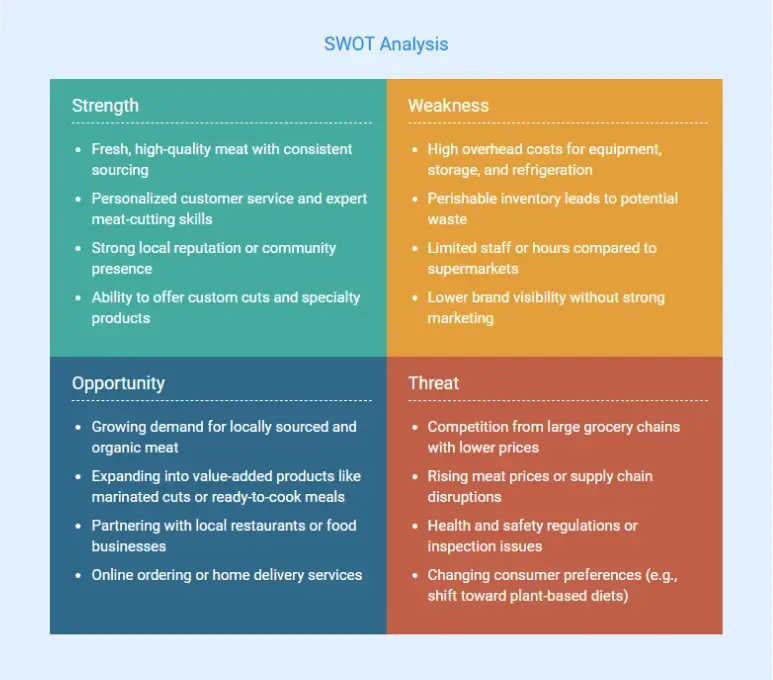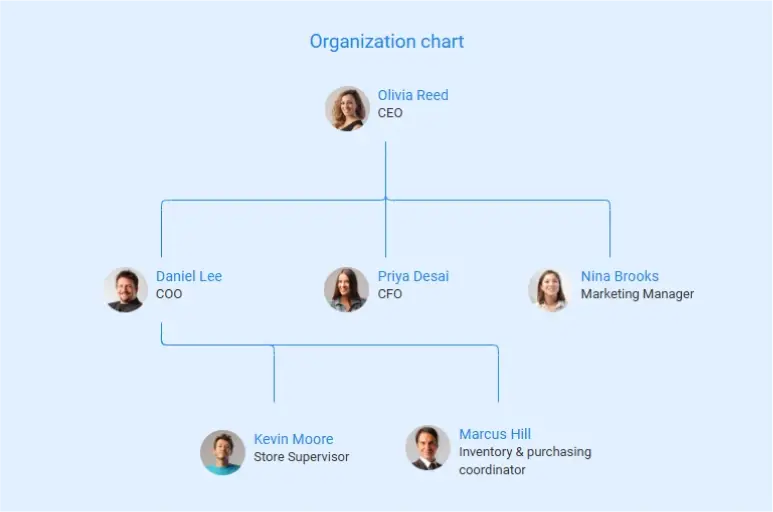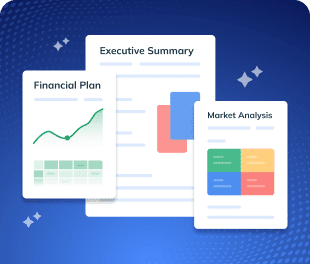Thinking about running a butcher shop?
It’s more than just carving premium cuts of meat—it’s a real business. You’re meeting a need for quality meats in your community and building a livelihood that can last.
But to turn that idea into something sustainable, you’ll need a solid plan for sourcing meat, setting prices, managing inventory, and attracting regular customers.
Not sure where to start?
This butcher shop business plan template guides you step by step through every section, enabling you to launch and grow your butcher shop with confidence.
What is a butcher shop business plan?
A butcher shop business plan is a written guide that sets out how your butcher shop will start, run, and grow. This guide includes: your goals, services, target markets and customers, competitors, marketing, daily operations, and financial plans.
In short, it’s a roadmap for your meat business. This helps you to be centered and prepared—and if you’re working with partners or investors are pitching, it shows them how your shop will be successful.
Why is a business plan important for a butcher shop?
Drafting a business plan can feel like an unnecessary hurdle when everyone in your shop is eager to start cutting steaks and serving customers. However, a business plan is crucial for a butcher shop for several practical reasons:
- Provides direction: Writing a business plan compels you to work through all aspects of the business, from sourcing meat, marketing, managing finances, and everything in between.
- Demonstrates viability: If you’re seeking a loan from the bank or seeking investors, a written business plan shows that your butcher shop has the potential to be profitable.
- Helps manage finances: A butcher shop includes significant costs (equipment, inventory, staff, refrigeration, etc.).
- Addresses competition and challenges: The meat retail industry can be competitive—supermarkets and online delivery services are all competing for customers. By researching and writing a plan, you’ll identify your competition and figure out how to differentiate your shop
- Guides day-to-day operations: Once you get up and run, your business plan acts as a reference to your objectives and standards.
In short, a business plan is important because it turns the idea of your butcher shop into a structured strategy. This enhances your confidence and preparations as an entrepreneur and enhances the possibility that your shop will flourish.
How to write a butcher shop business plan?
Creating a butcher shop business plan can feel overwhelming, but if you break it down into smaller sections, it will be easier to manage. Here’s how to develop your plan, step by step:
1. Executive Summary
The executive summary is the first section of your business plan, but it’s often easiest to write it last, after you’ve worked out the details in other sections.
This summary provides a snapshot of your entire plan, giving readers (like potential investors or lenders) a quick overview of your butcher shop and its potential.
In 1-2 pages, your executive summary should cover the highlights of your plan:
- Business concept
- Market and competition
- Operations
- Financial outlook
Keep the tone of the executive summary enthusiastic yet factual. The goal is to hook the reader’s interest so they want to learn more about your plan.
2. Business Overview
Business observation (or company observation) section gives readers a clear picture of who you’re and what your butcher shop does. In this section, describe the basic aspects of your business, including:
- Your butcher shop name, location, and legal structure. Are you the only owner, a partnership, or an LLC?
- What’s the mission of your butcher shop? Explain the purpose of your business, and in the long run, you expect to achieve what.
- If you’re a startup, you can just tell that you are a new venture. If you have already taken some steps, include those details.
- Observe what you sell. For now, just note whether you will focus on the latest cuts of beef, poultry, pork, lamb, etc.
- Does your butcher stand special? Emphasize any aspect that separates you. Highlighting your unique angle here sets the platform for the rest of your plan.
By the end of the business observation, the reader should have a concrete understanding of the identity of your butcher shop and what you are planning to do. Essentially, it answers the question: “What is this business really, and why will it be successful?”
3. Market Analysis
In the market analysis section, you’ll demonstrate your knowledge of the meat market and your target customers. A thorough market analysis proves that you’ve done your homework and that there is genuine demand for your butcher shop.
Here’s how to approach it:
Industry Overview
Start by describing the local and broader meat retail industry. Is the demand for butcher shops rising in your area? Mention trends like interest in organic meats, local sourcing, or quality home cooking. Use relevant data to support your points.
Target Market and Customer Analysis
Identify your ideal customers and why they’d pick your shop over a supermarket. Think of food lovers, restaurants, or families who want hormone-free meat. Define key customer segments clearly. Use customer analysis to show preferences and buying habits.
Location and Demographics
Describe the area you’ll serve and why it’s a good fit. It could be a food-focused city block or a suburb with few stores. Note population size and traits. Match the location to your target—premium buyers or bulk-seeking families.
Market Needs
Explain what’s missing in the local market that your shop can offer. Maybe it’s expert cuts, better service, or sustainable sourcing. Identify what customers want that supermarkets don’t provide. Show how your butcher shop fills that need.
Market Size and Growth
If available, add data on the local meat retail market size and growth. This helps show potential. Stats like “X% annual growth” support your case. Keep it regional, recent, and specific where possible to back up the opportunity.
Remember to also conduct a market analysis in broader terms: Know your industry regulations, seasonal fluctuations, and any emerging trends. Overall, this section should convince the reader that there is a healthy demand for your butcher shop and that you understand the market dynamics.
4. Competitive Analysis
Every business faces competition, and butcher shops are no exception. In the competitive analysis, you’ll identify who you’re up against and how you plan to stand out.
Start by listing your direct and indirect competitors:
- Direct competitors: There are other butcher shops nearby may be traditional or modern gourmet. Study their products, prices, customer base, and reputation. See what they do well and where they fall short to spot your edge.
- Indirect competitors: Includes supermarkets, farmers’ markets, and online delivery that offer meat with convenience or lower prices. Your shop must give customers a clear reason to choose you over their regular grocery trip.
- Competitive advantages: Highlight what makes your butcher shop stand out—better cuts, quality, service, or extras like marinades, delivery, smoked meats, or loyalty perks. Show why people will prefer your shop.
It can be helpful to perform a SWOT analysis (Strengths, Weaknesses, Opportunities, Threats) as part of your competitive analysis.

Now that you’ve outlined your strengths, weaknesses, opportunities, and threats, use that insight to shape your business strategy.
In your plan, clearly show how your butcher shop will stand out. Maybe no one else offers dry-aged beef, or others lack strong service. These are your chances to do better—and explain why your shop will succeed.
5. Core Offerings
The core offerings section details what products and services your butcher shop will provide. This is where you dive deeper into the specific things you’ll sell to generate revenue.
| Core Services | Summary |
|---|---|
| Meat Products | List main meats sold. Mention if they’re fresh, frozen, or both. Highlight quality standards. |
| Cuts & Preparation | Offer custom cuts, whole-animal butchery, or pre-cut options. Include any specialty cuts. |
| Value-Added Products | Add sausages, marinated or smoked meats, and related grocery items. |
| Services | Include delivery, online orders, event bundles, subscriptions, or classes. |
| Pricing Strategy | State if your pricing is premium or value-based compared to competitors. |
Describe your product line and any related services:
Ensure your core offerings align with what you described in your market analysis and competitive strategy.
For example, if you identified a local demand for organic meats, your offerings should emphasize that. If competitors lack ready-to-cook options, maybe your shop will shine there.
This section should make readers (and future customers) excited about what you’re selling.
6. Sales and Marketing Strategies
Build it and they will come” doesn’t always apply – even the best butcher shop needs solid sales and marketing strategies to attract and retain customers.
In this section of your plan, you’ll outline how you intend to get the word out about your shop and keep business booming. Consider covering the following:
- Branding
- Promotional tactics
- Online presence
- Community engagement
- Partnerships
- Loyalty and retention
Sales process
Briefly touch on how a sale will be made. For instance, will you have knowledgeable staff who can upsell (like suggesting a spice rub or an extra cut for the freezer)? If you offer phone or online orders, how will you handle those smoothly? Mention if you’ll use a modern point-of-sale system for quick checkouts and to manage inventory
Remember, your marketing plan should be tailored to your target audience and budget. A butcher shop might not need a huge advertising budget, but it does need smart, local marketing to build a loyal customer base. Show that you have a plan to create buzz and maintain steady sales.
7. Team and Management
Investors and lenders often say they invest in people as much as in ideas. The team and management section of your business plan will showcase who is running the butcher shop and why they are capable.
Here’s what to include:
Owners and Founders
Do you have experience in butchery, food service, or business management? Even if not, highlight any small business history, culinary training, or long-term interest—such as growing up in a butcher family or learning the craft over time.
Key team members
List key people involved. If you’ve hired a master butcher, mention their expertise. Include any partner or family member handling accounts, marketing, or operations. Note anyone essential to running the shop.
Roles and responsibilities
Clarify who does what. In small shops, roles often overlap—one person might manage sourcing and butchering, while another handles sales and admin. If solo, explain how you’ll cover all tasks, possibly with part-time help.
Organizational structure
If your team includes more than two people, include a simple structure. List roles like butchers, clerks, or drivers, and show who reports to whom.

Hiring plans
Share any hiring goals. Maybe you’ll start small, but plan to bring on a second butcher or cashier within a year. This shows readiness to grow with demand.
Advisors or mentors (optional)
If you have guidance from a mentor, retired butcher, or consultant, mention them briefly to boost your team’s credibility.
The goal of this section is to reassure readers that your butcher shop is (or will be) run by competent people. Even if you’re still filling some roles, acknowledging the need and having a plan for it indicates that you understand the operational requirements. I
8. Operations Plan
The operations plan outlines the practical everyday activities of your butcher shop, and considers the processes that take place behind the scenes.
The operations plan demonstrates you have sufficient knowledge of what needs to happen regularly for the business to function properly and the systems in place to ensure it functions as smoothly and efficiently as possible.
Key topics to cover include:
- Suppliers and sourcing: Describe how and where you will source your meat suppliers; are they local farms, distributors, or cooperatives?
- Equipment and facilities: List essential equipment for your butcher shop and how you intend to set it up.
- Meat processing and handling: Describe by including the entire processing of meat from delivery to customer sale.
- Inventory management: Explain how you’ll track inventory, reorder, and reduce spoilage.
- Daily operations: Outline operating hours, staffing, and shift duties.
- Technology and systems: Identify any software or tools used for sales, inventory, payroll, or online orders.
By covering these details, you reinforce to the reader that you have a concrete plan for the nuts-and-bolts of operating a butcher shop. You can have great products, but without a system of dependable processes, you have limited capacity to offer customers consistent and safe service.
9. Financial Projections
The financial projections section is where you lay out the numbers behind your plan—essentially, how your butcher shop will make money and grow over time.
This section can include several parts, but at a minimum, you should present forecasts for revenue, expenses, and profit.
Key components to include:
- Startup costs
- Sales projections
- Expense projections
- Profit & Loss forecast
- Cash flow projection
- Balance sheet projection
- Break-even analysis
- Funding requirements
Creating financial projections can be challenging, especially if you’re new to financial statements. Using tools or templates can help ensure your numbers are accurate and realistic.
Be prepared to explain your assumptions—why you expect a certain number of customers or profit margins. Your financials are a living document and can be updated once actual figures come in.
Download a free butcher shop business plan template
Ready to start crafting your own butcher shop business plan, but need help getting started? Don’t worry! Download our free butcher shop business plan template PDF to get going.
This professionally designed template is made specifically for butcher shops, including sections for equipment, meat sourcing, staffing, and financial planning. Use it as a reference while writing your plan, and feel free to customize it to match your shop’s vision and goals.
The Quickest Way to turn a Business Idea into a Business Plan
Fill-in-the-blanks and automatic financials make it easy.
Conclusion
We’ve walked through all the key parts of a butcher shop business plan—from concept and market research to operations and financial projections. You also have access to a free sample plan to guide your writing.
If you’d rather skip the manual formatting and focus on your business, try Upmetrics. It’s an AI-powered tool that helps you build a complete, professional business plan with step-by-step guidance and built-in financial forecasting.
Don’t wait! Use Upmetrics to turn your butcher shop idea into a solid business plan and a real, working shop.



